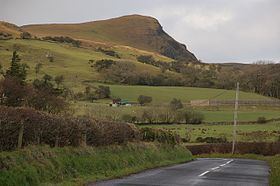OSI/OSNI grid D338090 Mountain type Volcanic plug Province Ulster | Topo map OSNI Discoverer 9 Elevation 378 m | |
 | ||
Similar Tievebulliagh, Black Mountain, Divis, Fair Head, Cavehill | ||
Scawt Hill is a volcanic plug in County Antrim, Northern Ireland, in the borough of Larne, 5 km from the village of Ballygalley.
Contents
- Map of Scawt Hill Larne UK
- Discovery of mineralsEdit
- Volcanic plugs in Northern IrelandEdit
- Early description of Scawt HillEdit
- Protected statusEdit
- Ulster WayEdit
- References
Map of Scawt Hill, Larne, UK
It gets its name from the Ulster Scots 'scawd' meaning scaly, scabby or rugged. Alternately, 'scawt' meaning scruffy and contemptible, and when applied to rocks, covered in barnacles.
Discovery of mineralsEdit
Scawt Hill is notable for being the type locality for several hydrated calcium silicates, that is, the place where they were first identified. These minerals were formed when the existing chalk of the area was intensely altered by the intrusion of the feeder tube of an ancient volcano, now long since cooled and eroded to its roots.
Minerals that were first discovered at Scawt Hill:
In all, 28 minerals have been found at this site.
Volcanic plugs in Northern IrelandEdit
Over 30 volcanic plugs are dotted through Northern Ireland, mostly along the Antrim coast like Scawt Hill, although they are relatively rare throughout the rest of Ireland. Volcanic plugs are often easy to spot. Their harder rock erodes away more slowly than their surroundings so they rise above the landscape as a hill.
The largest volcanic plug in Northern Ireland is the oval-shaped Slemish. At its widest, Slemish is over 1 km in diameter. Scawt Hill is more of a typically sized example. This olivine dolerite plug is 270 m x 180 m wide and rises 30 – 60 m above the Cretaceous white limestone, although the Antrim plateau around it is typically basalt.
The chalk at Scawt Hill has been transformed by high temperature and low pressure thermal metamorphism, developing the large and unusual range of calc-siliate minerals that have attracted interest. The rocks inside the vent were also changed by the contact, producing a sequence of alkali mafic igneous rocks as the magma assimilated the chalk, reducing the silica in the magma and leading to larger grain size near the contact.
Early description of Scawt HillEdit
Cecil Edgar Tilley, writing for the Mineralogical Magazine in 1929, was the first to appreciate the potential of the dolerite-limestone contact at Scawt Hill. Tilley named scawtite and larnite, and later, rankinite, and his writings inspired many others to find similar relationships between rocks worldwide.
Protected statusEdit
In 1995, Scawt Hill was categorised as an Area of Special Scientific Interest, not just for its international importance to geology, but for its plant life, where chalky and alkaline conditions are in close proximity, and for its conditions for breeding birds.
Ulster WayEdit
Scawt Hill is on the Ulster Way, part of a series of walking routes which encircle Ulster. It is passed by between the Black Hill and the Sallagh Braes.
